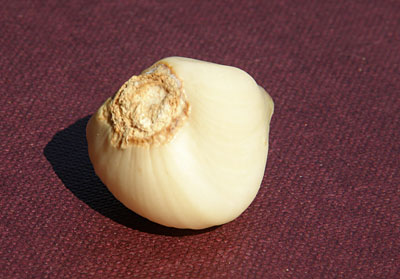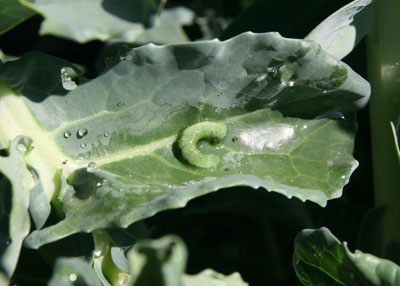Compiled by Eric Sideman, PhD, MOFGA’s Organic Crop Specialist
 |
 |
| Leafhopper burn | Squash bug eggs |
 |
 |
| Early blight on tomatoes | Septoria leaf spot |
As I write this it is raining again. Pouring you could say. Crops in soils with good drainage are doing well. Some soils have been waterlogged nearly every day of the season so far. Some crops have tolerated it well enough (sweet corn), and others have rotted away (ex. potatoes). Most crops are someplace between and have suffered a bit. The potato leafhopper is still active, and beans and potatoes left untreated in areas where they are plentiful are now showing hopperburn. Squash bug eggs are everywhere and soon the nymphs will be feeding. I recommend you be prepared for this (see the June 28, 2013 Pest Report). Late blight has only been reported in a few sites, and those pretty far away (MA, NJ, NY and one report in the County). Early blight and septoria leaf spot are running wild on tomatoes. It is a challenging year to farm or garden, and yet we have a wonderful bounty. I may sound like I am a pessimist but actually I recognize good fortune when I see it, and I see it now. Don’t worry.
In this issue:
Purple blotch in onions
Fusarium rot in garlic
Asiatic garden beetle
Imported cabbage worm
PURPLE BLOTCH ON ONION (Alternaria porri)
Purple blotch is a very common and sometime destructive disease that effects onions, garlic, shallots and leeks. Lesions begin as whitish sunken areas that elongate and develop purplish centers. Under favorable conditions (warm with wet leaves) the purple blotch lesions grow large and oval with concentric rings. The lesions may merge and take down whole leaves, and may become covered with brownish spores. The older leaves are more susceptible than the younger leaves.
Onion residue is the source of the disease in the spring. The fungal mycelium and conidia spores persist as long as the onion debris in the field or in cull piles. New conidia are produce on infected tissue in the spring and wind blown or carried in water to the new crop. The leaves have to have liquid water on them for the spores to germinate, but germination is very quick, less than an hour. Symptoms may appear in less than a week after germination and new conidia spores are quickly produced.
 |
| Purple blotch on onion leaves. |
 |
 |
| Fusarium rot on garlic. Lower photo by Crystal Stewart. |
 |
| Asiatic Garden Beetle. |
 |
| Imported cabbage worm |
Cultural Control
Sanitation is very important to limiting spread. Infected crop debris should be destroyed or buried after harvest. Cull piles should not be kept near the new onion field. Onions should be grown in rotation with non host crops.
Materials Approved for Organic Production
Serenade has been shown to be effective against purple blotch.
FUSARIUM ROT ON GARLIC (Fusarium oxysporum f. sp. cepae)
Now is the time to harvest garlic, or at least it will be shortly. And it is the time to check for problems. It is very important to determine if you have a problem with the garlic bloat nematode (see the June 28, 2013 Pest Report), or white rot (see the July 7, 2010 Pest Report. It may be a good time to pull out your copy of the Resource Guide to Organic Insect and Disease Management and read the Allium chapter* and become familiar with some other nasty garlic problems such as Botrytis rot and Penicillium decay.
Fusarium rot superficially looks like bloat nematode damage. The pathogen invades the basal plate and the roots decay and die. If the infection took place late in the season, then you may not see symptoms until the garlic is in storage.
Fusarium is a fungus that persists in soils as resting spores. Warm, moist soil favors development of the disease. Under very moist conditions a pinkish-white mycelium may develop making the symptoms a bit like white rot. If you are unsure whether your problem is the bloat nematode, white rot, or fusarium rot then you should send a sample into the Pest Management Office for identification (https://umaine.edu/ipm/ipddl/).
If you have a fusarium problem, then a three year rotation to crops other than any Allium is recommended. Garlic should be stored in a cool (32-36 degrees F.), dry place in order to slow the development of the disease. (see the MOFGA fact sheet Storing Garden Vegetables.
* The new edition of the Resource Guide can be ordered or viewed as a pdf at: https://web.pppmb.cals.cornell.edu/resourceguide/ or you can order a copy from MOFGA. Call the office (207-568-4142) or buy online at the MOFGA Store. $20.00
Top
Asiatic Garden Beetle (Maladera castanea)
I have received a few reports of activity of this critter. The Asiatic Garden Beetle is a native of Japan and China where it is not an important pest. The pest overwinters in the soil as a grub feeding on the roots in sod ground and weedy gardens. Some farmers are reporting problem with the grubs in their crop fields. The larvae (grubs) pupate early in the spring and the resulting adults emerge in June and start feeding on all sorts of garden vegetables. The adults are cinnamon-to reddish brown, rounded beetles. They eat big and irregular holes in the leaves and blossoms. You have to look hard to find them because they feed at night and burrow into the soil for the day. If you see chewed leaves and no pest, then go out at night with a flashlight and see who is there. It will probably be cutworms, or the Asiatic garden beetle. If you have the problem, fall clean up with tilling the garden is important. Pesticides offer some control but often they are very numerous and seem to return from nowhere. Spinosad (Entrust and Montery Garden Spray) have been reported to work well.
For information about the other scarab beetles (including the Japanese beetle and oriental beetle) see the August 9, 2010 Pest Report.
IMPORTED CABBAGE WORM (Pieris rapae)
The white butterflies are flying all around the cabbage family plants now and laying eggs, and the larvae (green caterpillars) are chewing holes in the leaves. If you have heading broccoli or cabbage you must know your customers because some folks are really turned off by the critters floating to the top of the water in the cooking pot. You may want to spray even though the crop is beyond risk.
This pest overwinters as a pupa and there are 3-4 generations per year. This means that once you start seeing the butterfly you should start scouting for the caterpillar in about a week. Bt (Dipel 2X or Dipel DF) or Entrust work very well in controlling the caterpillar. None of these materials lasts in the field and so should only be sprayed when the caterpillars are there in large enough numbers to warrant it.
Destroy or bury crop residue after harvest so as not to allow the caterpillars to continue to feed and complete their life history and thus a larger second generation later in the season.
